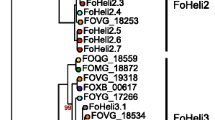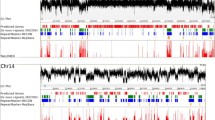Abstract
We describe the structure, organization, and transcriptional impact of repetitive elements within the lignin-degrading basidiomycete, Phanerochaete chrysosporium. Searches of the P. chrysosporium genome revealed five copies of pce1, a ~1,750-nt non-autonomous, class II element. Alleles encoding a putative glucosyltransferase and a cytochrome P450 harbor pce insertions and produce incomplete transcripts. Class I elements included pcret1, an intact 8.14-kb gypsy-like retrotransposon inserted within a member of the multicopper oxidase gene family. Additionally, we describe a complex insertion of nested transposons within another putative cytochrome P450 gene. The disrupted allele lies within a cluster of >14 genes, all of which encode family 64 cytochrome P450s. Components of the insertion include a disjoint copia-like element, pcret3, the pol domain of a second retroelement, pcret2, and a duplication of an extended ORF of unknown function. As in the case of the pce elements, pcret1 and pcret2/3 insertions are confined to single alleles, transcripts of which are truncated. The corresponding wild-type alleles are apparently unaffected. In aggregate, P. chrysosporium harbors a complex array of repetitive elements, at least five of which directly influence expression of genes within families of structurally related sequences.





Similar content being viewed by others
References
Cambareri EB, Aisner R, Carbon J (1998) Structure of the chromosome VII centromere region in Neurospora crassa: degenerate transposons and simple repeats. Mol Cell Biol 18:5465–5477
Canters GW, Gilardi G (1993) Engineering type 1 copper sites in proteins. FEBS Lett 325:39–48
Chomet P, Lisch D, Hardeman KJ, Chandler VL, Freeling M (1991) Identification of a regulatory transposon that controls the Mutator transposable element system in maize. Genetics 129:261–270
Cullen D, Kersten PJ (2004) Enzymology and molecular biology of lignin degradation. In: Brambl R, Marzulf GA (eds) The Mycota III biochemistry and molecular biology. Springer, Berlin Heidelberg New York, pp 249–273
Daboussi MJ, Capy P (2003) Transposable elements in filamentous fungi. Annu Rev Microbiol 57:275–299
DeMarco R et al (2004) Saci-1, -2, and -3 and Perere, four novel retrotransposons with high transcriptional activities from the human parasite Schistosoma mansoni. J Virol 78:2967–2978
Deschamps F, Langin T, Maurer P, Gerlinger C, Felenbok B, Daboussi MJ (1999) Specific expression of the Fusarium transposon Fot1 and effects on target gene transcription. Mol Microbiol 31:1373–1383
Diez J, Beguiristain T, Le Tacon F, Casacuberta JM, Tagu D (2003) Identification of Ty1-copia retrotransposons in three ectomycorrhizal basidiomycetes: evolutionary relationships and use as molecular markers. Curr Genet 43:34–44
Doddapaneni H, Chakraborty R, Yadav JS (2005) Genome-wide structural and evolutionary analysis of the P450 monooxygenase genes (P450ome) in the white rot fungus Phanerochaete chrysosporium: evidence for gene duplications and extensive gene clustering. BMC Genomics 6:92
Eriksson KE, Hamp SG (1978) Regulation of endo-1,4-β-glucanase production in Sporotrichum pulverulentum. Eur J Biochem 90:183–190
Fowler TJ, Mitton MF (2000) Scooter, a new active transposon in Schizophyllum commune, has disrupted two genes regulating signal transduction. Genetics 156:1585–1594
Fridell R, Pret A, Searles L (1990) A retrotransposon 412 insertion within an exon of the Drosophila melanogaster vermillion gene is spliced from the precursor RNA. Genes Dev 4:559–566
Fudal I, Bohnert HU, Tharreau D, Lebrun MH (2005) Transposition of MINE, a composite retrotransposon, in the avirulence gene ACE1 of the rice blast fungus Magnaporthe grisea. Fungal Genet Biol 42:761–772
Gaskell J, Vanden Wymelenberg A, Cullen D (1995) Structure, inheritance, and transcriptional effects of Pce1, an insertional element within Phanerochaete chrysosporium lignin peroxidase gene lipI. Proc Natl Acad Sci USA 92:7465–7469
Goodwin TJ, Poulter RT (2000) Multiple LTR-retrotransposon families in the asexual yeast Candida albicans. Genome Res 10:174–191
Goodwin TJ, Poulter RT (2004) A new group of tyrosine recombinase-encoding retrotransposons. Mol Biol Evol 21:746–759
Graham SE, Peterson JA (1999) How similar are P450s and what can their differences teach us? Arch Biochem Biophys 369:24–29
Hood ME (2005) Repetitive DNA in the automictic fungus Microbotryum violaceum. Genetica 124:1–10
Hua-Van A, Daviere JM, Kaper F, Langin T, Daboussi MJ (2000) Genome organization in Fusarium oxysporum: clusters of class II transposons. Curr Genet 37:339–347
Jordan IK, McDonald JF (1999) Tempo and mode of Ty element evolution in Saccharomyces cerevisiae. Genetics 151:1341–1351
Kang S (2001) Organization and distribution pattern of MGLR-3, a novel retrotransposon in the rice blast fungus Magnaporthe grisea. Fungal Genet Biol 32:11–19
Kang S, Lebrun MH, Farrall L, Valent B (2001) Gain of virulence caused by insertion of a Pot3 transposon in a Magnaporthe grisea avirulence gene. Mol Plant Microbe Interact 14:671–674
Kempken F, Kuck U (1998) Transposons in filamentous fungi-facts and perspectives. BioEssays 20:652–659
Kim JM, Vanguri S, Boeke JD, Gabriel A, Voytas DF (1998) Transposable elements and genome organization: a comprehensive survey of retrotransposons revealed by the complete Saccharomyces cerevisiae genome sequence. Genome Res 8:464–478
Larrondo L, Salas L, Melo F, Vicuna R, Cullen D (2003) A novel extracellular multicopper oxidase from Phanerochaete chrysosporium with ferroxidase activity. Appl Environ Microbiol 69:6257–6263
Larrondo L, Gonzalez B, Cullen D, Vicuna R (2004) Characterization of a multicopper oxidase gene cluster in Phanerochaete chrysosporium and evidence for altered splicing of the mco transcript. Microbiology 150:2775–2783
Martinez D et al (2004) Genome sequence of the lignocellulose degrading fungus Phanerochaete chrysosporium strain RP-78. Nat Biotechnol 22:695–700
Nishimura M, Hayashi N, Jwa NS, Lau GW, Hamer JE, Hasebe A (2000) Insertion of the LINE retrotransposon MGL causes a conidiophore pattern mutation in Magnaporthe grisea. Mol Plant Microbe Interact 13:892–894
Plant EP, Goodwin TJ, Poulter RT (2000) Tca5, a Ty5-like retrotransposon from Candida albicans. Yeast 16:1509–1518
Poulter RT, Goodwin TJ, Butler MI (2003) Vertebrate helentrons and other novel Helitrons. Gene 313:201–212
Rezsohazy R, van Luenen HG, Durbin RM, Plasterk RH (1997) Tc7, a Tc1-hitch hiking transposon in Caenorhabditis elegans. Nucleic Acids Res 25:4048–4054
Rushforth AM, Anderson P (1996) Splicing removes the Caenorhabditis elegans transposon Tc1 from most mutant pre-mRNAs. Mol Cell Biol 16:422–429
Smith TF, Waterman MS (1981) Identification of common molecular subsequences. J Mol Biol 147:195–197
Sonnenberg AS, Baars JJ, Mikosch TS, Schaap PJ, Van Griensven LJ (1999) Abr1, a transposon-like element in the genome of the cultivated mushroom Agaricus bisporus (Lange) Imbach. Appl Environ Microbiol 65:3347–3353
Stewart P, Gaskell J, Cullen D (2000) A homokaryotic derivative of a Phanerochaete chrysosporium strain and its use in genomic analysis of repetitive elements. Appl Environ Microbiol 66:1629–1633
Thompson JD, Higgins DG, Gibson TJ (1994) ClustalW improving the sensitivity of progressive multiple sequence alignment through sequence weighting, position-specific gap penalties and weight matrix choice. Nucleic Acids Res 22:2552–2556
Thon MR, Martin SL, Goff S, Wing RA, Dean RA (2004) BAC end sequences and a physical map reveal transposable element content and clustering patterns in the genome of Magnaporthe grisea. Fungal Genet Biol 41:657–666
Tien M, Tu C-PD (1987) Cloning and sequencing of a cDNA for a ligninase from Phanerochaete chrysosporium. Nature 326:520–523
Vanden Wymelenberg A et al (2002) Transcript analysis of genes encoding a family 61 endoglucanase and a putative membrane-anchored family 9 glycosyl hydrolase from Phanerochaete chrysosporium. Appl Environ Microbiol 68:5765–5768
Vanden Wymelenberg A et al (2005) The Phanerochaete chrysosporium secretome: database predictions and initial mass spectrometry peptide identifications in cellulose-grown medium. J Biotechnol 118:17–34
Vanden Wymelenberg A et al (2006) Computational analysis of the Phanerochaete chrysosporium v2.0 genome database and mass spectrometry identification of peptides in ligninolytic cultures reveals complex mixtures of secreted proteins. Fungal Genet Biol 43:343–356
Weil C, Wessler S (1990) The effects of plant transposable element insertion on transcription initiation and RNA processing. Annu Rev Plant Physiol Plant Mol Biol 41:527–552
Wostemeyer J, Kreibich A (2002) Repetitive DNA elements in fungi (Mycota): impact on genomic architecture and evolution. Curr Genet 41:189–198
Acknowledgments
This work was supported by U.S. Department of Energy grant no. DE-FG02-87ER13712 and the Millenium Institute for Fundamental and Applied Biology and by grant 1030495 from FONDECYT, Chile. Nucleotide sequence data reported are available in GenBank under accession numbers DQ400694, DQ444269, AY532142, DQ444268, and DQ677350.
Author information
Authors and Affiliations
Corresponding author
Additional information
Nucleotide sequence data reported are available in GenBank under accession numbers DQ400694, DQ444269, AY532142, DQ444268 and DQ677350.
Rights and permissions
About this article
Cite this article
Larrondo, L.F., Canessa, P., Vicuña, R. et al. Structure and transcriptional impact of divergent repetitive elements inserted within Phanerochaete chrysosporium strain RP-78 genes. Mol Genet Genomics 277, 43–55 (2007). https://doi.org/10.1007/s00438-006-0167-z
Received:
Accepted:
Published:
Issue Date:
DOI: https://doi.org/10.1007/s00438-006-0167-z




